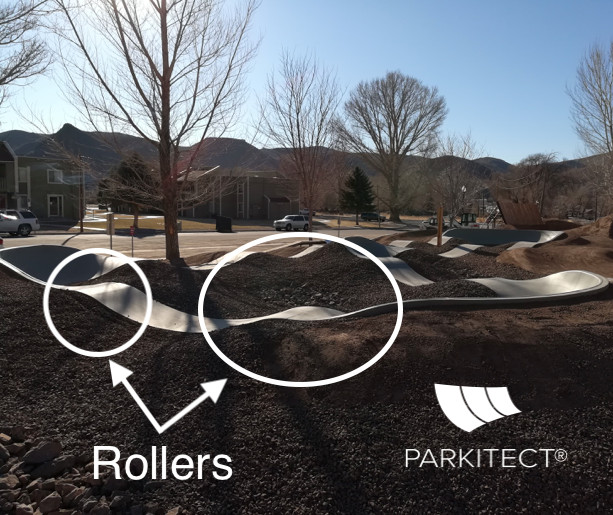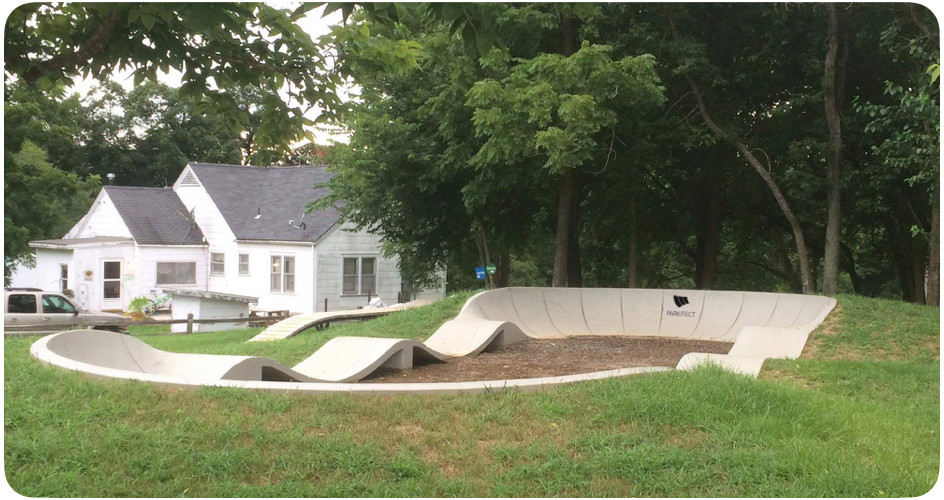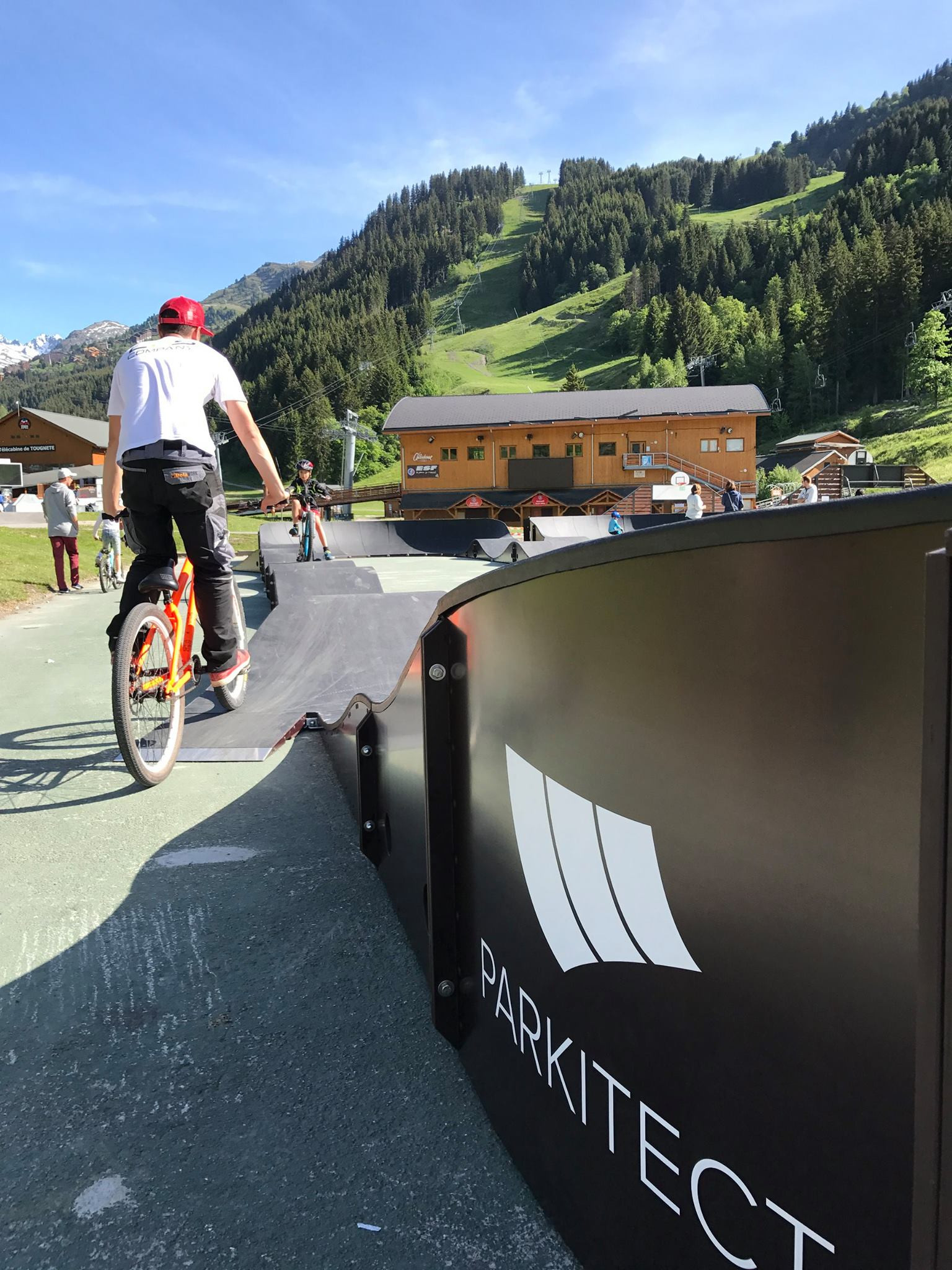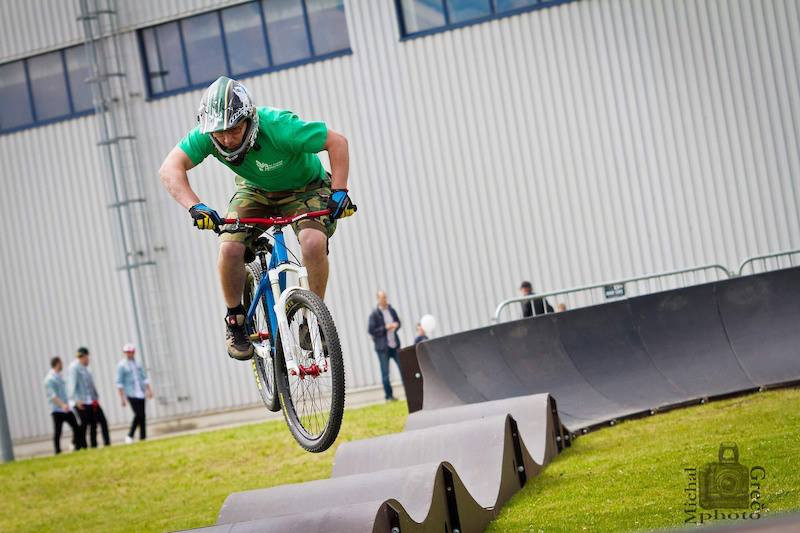Animation demonstrating the pumping motion used to ride a pumptrack.
We often encounter this question: “What is a pumptrack?” It’s a common query when we discuss our work, and a quick Google search for “pumptrack” reveals that “what IS a pumptrack?” is a top related search. So, let’s provide a comprehensive answer to this question once and for all.
Beyond being a trending and innovative amenity in public spaces and backyards alike, a Bike Pump Track is a continuous loop of rollers and berms designed for wheeled sports. The unique feature of a pump track is that when ridden correctly, it requires no pedaling or pushing. Instead, riders use a “pumping” motion—an up and down body movement—to generate and maintain momentum (refer to the animation above for a visual demonstration).
“Kids love them, amateurs love them, pros love them. Bike pump tracks should be in every town just like kids’ playgrounds or soccer fields. Pumptracks get people involved in sports, get them together, get them to have fun outside and do something for their health!”
Claudio Caluori, Founder, Velosolutions
See Redbull “Crashed Ice” star Markus Iuola showcase how to ride a pumptrack on our concrete pumptrack in Helsinki, Finland:
Understanding Bike Pump Track Design: Berms and Rollers
A bike pump track is essentially a circuit composed of a sequence of rollers…
 A PARKITECT modular pumptrack made of pre-cast concrete integrated into a park setting. The track features a series of smooth, rolling bumps.
A PARKITECT modular pumptrack made of pre-cast concrete integrated into a park setting. The track features a series of smooth, rolling bumps.
…and berms.
Rollers are the smooth, rounded mounds or bumps that you’ll ride over, while berms are the banked turns that allow you to maintain speed and flow through corners.
The “pump” in “pump track” refers to the crucial pushing-down and pulling-up motion that riders execute in sync with the track’s features. This pumping action is the primary source of propulsion, enabling riders to navigate the entire track without ever pedaling or pushing. It’s an exhilarating experience, offering a rollercoaster-like sensation of weightlessness as you move up and down, but on a smaller, more manageable scale. Bike pump tracks are intentionally designed to be ridden using this pumping technique.
Materials and Construction of a Bike Pump Track
Bike pump tracks are constructed using various materials, each offering unique characteristics and benefits.
Dirt Pump Tracks
 Enthusiastic crowd of riders and spectators at the Philly Pumptrack, a community-built dirt track.
Enthusiastic crowd of riders and spectators at the Philly Pumptrack, a community-built dirt track.
Dirt was the original material for pump tracks, and it remains a popular and cost-effective choice. Building a dirt pump track requires minimal tools – primarily shovels and manual labor. This makes it accessible for community projects and DIY enthusiasts. However, dirt pump tracks demand more upkeep. Weather and frequent use can degrade the shape and surface, necessitating regular maintenance to keep the track in optimal riding condition.
Wood Pump Tracks
Wood is another option for constructing pump tracks, though less common. While wood can offer a unique aesthetic, it can become slippery when wet, posing a safety concern in varying weather conditions. Our founder, Erik, built one of the earliest tracks from wood at the Finale Ligure bike park, learning firsthand about the material’s pros and cons.
Concrete Pump Tracks
 A durable PARKITECT modular pumptrack made of precast concrete in Sweden, blending seamlessly with the urban landscape.
A durable PARKITECT modular pumptrack made of precast concrete in Sweden, blending seamlessly with the urban landscape.
Concrete represents a significant upgrade in material quality for pump tracks. Constructing a concrete pump track involves more upfront planning and investment, but the payoff is reduced maintenance and increased longevity. PARKITECT offers modular pumptracks in precast concrete, which can be integrated into landscapes or installed as standalone, above-ground structures.
Asphalt Pump Tracks
Asphalt is frequently chosen for building pump tracks that are meant to be permanent fixtures within a landscape. It’s a highly durable and low-maintenance material, resulting in a long-lasting, dedicated pump track facility. The primary hurdle for many projects is the higher initial cost of asphalt and the necessary planning and permits. It’s also worth noting that falls on asphalt can be less forgiving than on softer surfaces.
Fiberglass Composite Pump Tracks
 A vibrant PARKITECT modular pumptrack made of fiberglass composite, designed for resilience and high performance.
A vibrant PARKITECT modular pumptrack made of fiberglass composite, designed for resilience and high performance.
Fiberglass composite is an exceptionally resilient material for pump tracks, offering superior performance in harsh weather and under heavy use. Fiberglass pump tracks require minimal maintenance over many years and are the most popular type of modular pump track we provide at PARKITECT, known for their durability and consistent riding surface.
Often, pump track projects incorporate a combination of materials to create hybrid facilities. This approach caters to diverse user preferences and optimizes different sections of the track based on material properties.
Bike pump tracks can be beautifully integrated into the surrounding landscape, creating a seamless blend of recreation and nature.
 A PARKITECT modular pumptrack made of precast concrete, naturally integrated into a park environment, highlighting landscape harmony.
A PARKITECT modular pumptrack made of precast concrete, naturally integrated into a park environment, highlighting landscape harmony.
Alternatively, they can be installed as permanent above-ground structures, offering flexibility in placement and design.
 A PARKITECT modular pumptrack made of composite material, installed above ground, demonstrating a clean, standalone recreational feature.
A PARKITECT modular pumptrack made of composite material, installed above ground, demonstrating a clean, standalone recreational feature.
And due to their modular nature, pump tracks can even be set up for temporary events and exhibitions.
What Equipment Can You Use on a Bike Pump Track?
We’re often asked about the types of equipment suitable for pump tracks. While we’ve even seen kids enjoy them on foot, here’s a handy guide to what works best – and what to avoid – on a bike pump track:
| Suitable Equipment ✅ | Not Suitable ❌ |
|---|---|
| Bicycles (Mountain Bikes, BMX Bikes, Strider Bikes, etc.) ✅ | Strollers ❌ |
| Scooters ✅ | Tricycles ❌ |
| Skateboards ✅ | Carts ❌ |
| Roller Blades ✅ | Wagons ❌ |
| Longboards ✅ | Bikes with training wheels ❌ |
Who Can Enjoy a Bike Pump Track?
Everyone! Bike pump tracks are increasingly popular public sports amenities because they cater to “all ages, all abilities,” providing a wealth of benefits. Learning to ride a pump track is intuitive, with most people grasping the basics within a few laps, whether they are 2 or 82 years old. Pump tracks are excellent for developing essential bike-handling and mountain biking skills and offer a safe alternative for children, keeping them away from busy streets. These are just a few of the many reasons why the ROI of a pump track is highly positive for communities and individuals alike.
“Pump tracks are the foundation for many action sports. Kids learn bike, skateboard, and scooter handling skills with minimal risk of injury. Modular pump tracks are far more accessible than traditional skateparks, encouraging broader participation in sports. I believe pump tracks should be as common in every town as a soccer field.”
Joost Wichman, 2013 UCI 4x World Champion
 A toddler confidently rides a PARKITECT modular pumptrack, demonstrating accessibility for even the youngest riders.
A toddler confidently rides a PARKITECT modular pumptrack, demonstrating accessibility for even the youngest riders.
 A professional male rider executes tricks on a PARKITECT modular pumptrack, illustrating the appeal to experienced athletes.
A professional male rider executes tricks on a PARKITECT modular pumptrack, illustrating the appeal to experienced athletes.
A Bike Pump Track: Above All, It’s Fun!
Loops, rollers, berms, bikes, scooters, skateboards, rollerblades, dirt, concrete, asphalt, fiberglass, for the young and the old – a bike pump track encompasses many things. But what truly makes them popular is simply how much fun they are. Our advice? Find a pump track near you and experience it firsthand. The best way to understand a bike pump track is to ride one. #rideon #allagesallabilities
What does a bike pump track mean to you? Share your thoughts in the comments below! 👇
[
